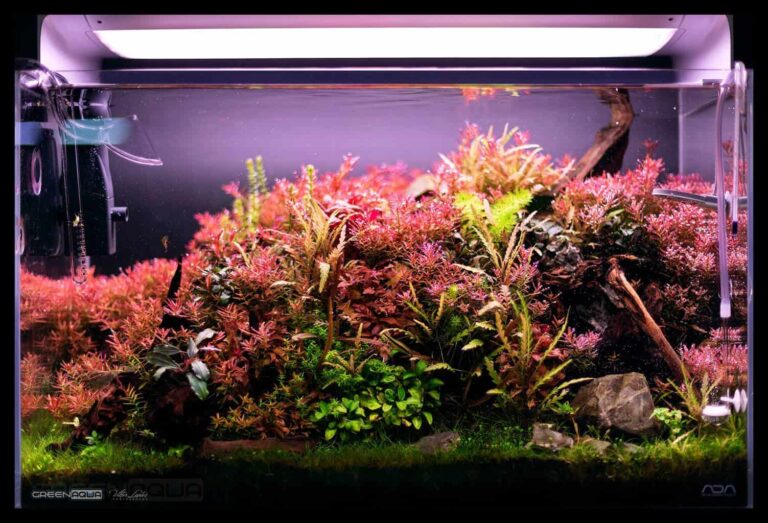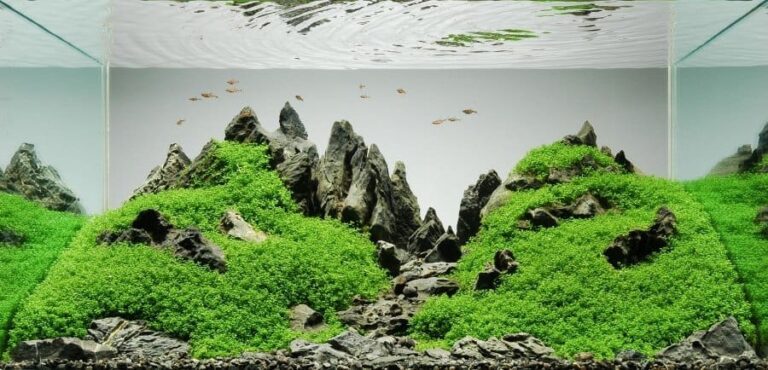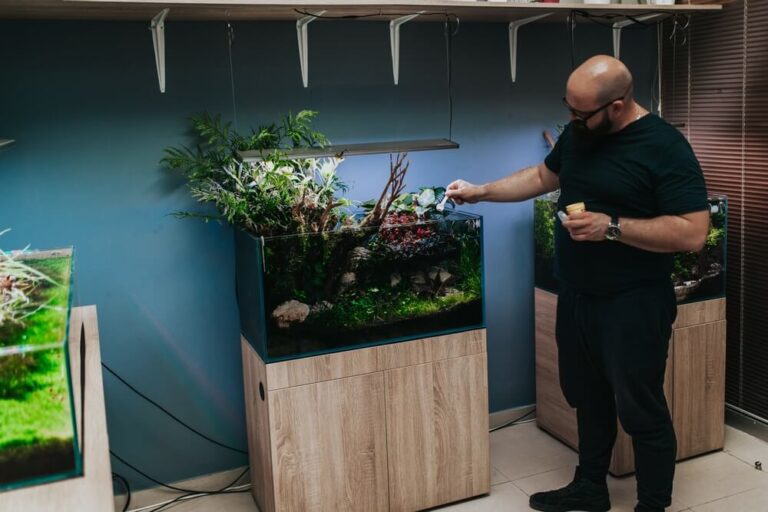Let’s get acquainted with aquarium carpet plants! The name says what they are, isn’t it? Carpet plants are kinds of live aquatic plants that spread themselves along the substrate, forming a natural carpet in the aquarium.
Live aquarium plants can accompany your aquarium journey with many benefits. Besides enhancing the aesthetic appeal, they establish a healthy environment for fish. Carpet plants are not any exception; they can consume toxicity, add freshness, and present a more vibrant aquarium visual!
In this article, we’ve formed an 11 members team that makes perfect inflection as the best aquarium carpet plants for beginners.
Why carpet plants are harder to grow
Carpet plants are the hardest to grow in a planted aquarium and that is for a valid reason.Let’s check out the prerequisites for a thriving planted aquarium with lush carpet –
- First of all, carpet plants grow at the substrate level where light penetrates the least.So, you will need good light source with high PAR.
- Secondly, carpet plants have tiny roots and as a result you need finer substrates (preferably commercial ones)
- Thirdly, carpet plants are high demanding. As the roots are very tiny they consume nutrients from water column. So, regular fertilizer dosing is essential and you need to ensure pressurized CO2 supply for carpet plants to thrive.
Now, as a beginner, you may not fulfill all the demands and it becomes even harder for you. But don’t worry. In this article we will find you a way to have a carpet with minimal effort in your low tech fish tank.
What Features Make Carpet Plants Beginner-Friendly
Easy to grow:
Carpet plants for newbies should be easy to grow, low tech and with as few hassles and curbs on the path as possible. Often the beginners end up having trouble growing plants due to the result of wrong selection. Picking carpet plants that are hardy and adaptable in diverse circumstances is the appropriate step for beginners.
Fast-growing:
Well, probably you want your fish tank to be all set and mimics your fancy underwater world as soon as possible after the start. Faster growing carpet plants will help the beginners to get the aquarium quickly in preferred shape. But at the same time, the fast-growing carpet plants require a little more frequent trimming.
Low light requiring:
Carpets lay at the bottom of the tank, at the furthest point from the tank lighting source. So, carpeting plants require more intense lighting than others. Picking the right aquarium light is vital for growing all kinds of live aquarium plants, and carpet plants are no exception. But the first-timers may not want to invest in a high-tech lighting system. Though their urge for light is unavoidable, alternatively, you can choose low light requiring carpet plants.
Less CO2 demanding:
CO2 is biologically essential for all kinds of aquarium plants, so it is impractical to expect your carpeting plants flourishing without a sufficient level of CO2 available for them. At some point, you might need to inject CO2 for your carpet plants to thrive. But CO2 adding is a highly tricky task, as overdosing of high CO2 can be deadly for fish. As a beginner, you can avoid this task simply picking plants that require less CO2.
Flexible with substrates:
Carpeting plants root the substrate to draw nutrients from it. So, the aquarium substrate is another crucial consideration for picking carpeting plants. Nutrient-rich fine gravels are fairly suitable for most of the aquarium carpet plants. As a newbie, you should limit yourself choosing orthodox companions and circumvent those who require special substrates.
11 Best Aquarium Carpeting Plants For Beginners
Considering the limitations we have selected 11 plants that are less demanding, hardy and would be easier for beginners to grow them successfully.
1. Dwarf Harigrass

- Scientific Name: Eleocharis parvula
- Care Level: Easy
- Growth Rate: Fast
- Light Requirement: Moderate
- CO2 Supplement: Optional
The name describes them superbly! They are grass-like plants having green strands as thin as hair. Dwarf Hairgrass is an excellent choice as carpet plants to make awesome fish tank lawns.
Dwarf Hairgrass is hardy, adaptable, and easy-to-care, thus becoming one of the best carpet plants for beginners. Though moderate lighting is good for the proper photosynthesis of this species, it can grow in low lights anyway.
Typically, Dwarf Hairgrass in shops is available in potted clumps. You can split Dwarf Hairgrasses into sections of 4 to 6 strands, and plant them in a grid pattern to get a better result. Uniform planting on a fertile substrate will be very effective in creating your desired luscious green carpet within a short time.
Dwarf Hairgrass is very fast-growing and propagate quickly along the entire bottom of the tank forming a dense carpet. You have to trim them regularly to keep in good shape, and trimming is the only maintenance that Dwarf Grass needs. If the propagation of your Dwarf Hairgrass is not satisfactory, probably they are not getting sufficient light.
2. Monte Carlo
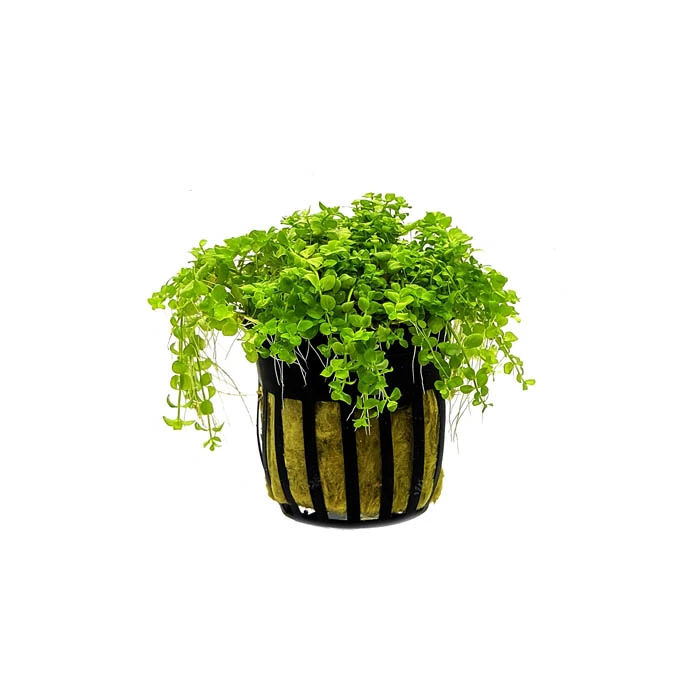
- Scientific Name: Micranthemum tweediei
- Care Level: Easy
- Growth Rate: Moderate
- Light Requirement: Moderate
- CO2 Supplement: No
Monte Carlo is a newer addition of aquarium carpeting plants, which is named after a city in Argentina. Japanese researchers discovered some specimens of Micranthemum, years ago, on the riverside of Monte Carlo city. They have rounded light green leaves that make a perfect accent of aquarium carpeting. In another name, they are known as “New Large Pearl Grass.”
Monte Carlo is a medium-light carpet plant and grows better in fine sand substrates as most other carpet plants do. An additional CO2 supplement is not essential for Monte Carlo to flourish.
Potted clumps of Monte Carlo are readily available from pet stores and online vendors. For a small aquarium of 5 to 10 gallons, one or two pots are adequate. You can split the plant into pieces and dip them uniformly throughout the substrate. For firm rooting, make sure to dip them into enough depth.
The first trimming requires meticulous care and might be a little tedious. Apart from trimming, no special care is necessary for Monte Carlo.
3. Micro Sword (Lilaeopsis brasiliensis)
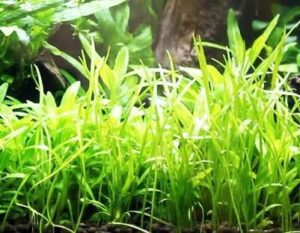
- Scientific Name: Lilaeopsis novae-zelandiae
- Care Level: Easy
- Growth Rate: Medium
- Light Requirement: Moderate to High
- CO2 Supplement: Optional
Micro Swords are grass-like green plants, and great for creating an eye-catching aquarium carpet. They are slightly thicker than Dwarf Hairgrass in appearance. The shiny green color can make an excellent foreground of your fish tank.
Micro Sword grows faster in bright lights and propagates a little slower in low-tech aquariums. Still, it’s very easy to care; thus, an excellent choice for the first-timers to start with. Provide a nutrient-rich substrate, and your Micro Sword carpet will thrive.
Planting of Micro Sword is somewhat tricky but manageable. The seedlings have light and week roots, and they can’t hold the substrate firmly. After you bought plant clumps, split them into smaller clumps, and plant uniformly one to two inches apart. It is advisable to dip the roots at least half inches down.
Like all other carpet aquarium plants, Micro Sword requires proper trimming. No other special care is essential for growing them.
4. Brazilian Micro Sword
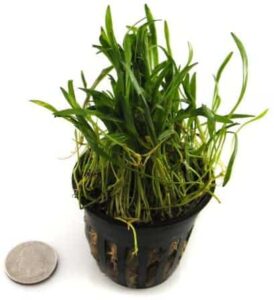
- Scientific Name: Lilaeopsis brasiliensis
- Care Level: Easy
- Growth Rate: Medium
- Light Requirement: Moderate to High
- CO2 Supplement: Optional
Brazilian Micro Sword is from the Lilaeopsis family, and they make excellent natural carpets for freshwater aquariums. They are native to South America and vastly found alongside riverbanks all around Brazil, Argentina, and Paraguay.
Lilaeopsis Novae-Zelandiae grows compact in high light to create awesome lawn effects with a bright green appearance. They are easy-to-care plants, hence compete for one of the best carpet plants for beginners.
For planting, snip the plants into several portions with sets of roots and leaves. Roots of the young plants are very sensitive, so insert them very carefully into the substrate. To achieve the faster formation of a carpet, cover the entire substrate and plant uniformly with a one-inch spacing.
Brazilian Micro Sword does not do well in low lights and sheds. Ensure sufficient lighting with proper nutrition. Trim your grasses frequently.
5. Marsilea Hirsuta
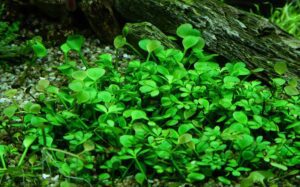
- Scientific Name: Marsilea hirsuta
- Care Level: Easy
- Growth Rate: Slow to Medium
- Light Requirement: Low to Medium
- CO2 Supplement: Optional
Marsilea Hirsuta is an easy to care aquarium plant which qualifies in our list of the best aquarium carpet plants for beginners. They are freshwater plants, native to the Australian islands. Marsilea Hirsuta has a four-lobed leaf structure with a dark green appearance. They are known as fascinating dense carpet makers.
Marsilea Hirsuta is highly adaptable and hardy, so beginners will have an easy time growing it. Even in low lights, they do well but tend to grow taller instead of spreading along, which is manageable anyway.
The plantlets may come in cups, with several plants per cup. Take them out of the cup, wash thoroughly, and then split into 6/7 portions with a scissor. For more effective planting, take at least one inch from the plant’s rhizome section. The rest of the job is straightforward; simply insert them uniformly into the substrate.
Once a transitional period is over, it starts to develop leaves in different shapes, forms runners, and spreads rapidly along to substrate, creating a stunning carpet look. Marsilea Hirsuta is a low maintenance carpet plant and only requires occasional trimming.
6. Glossostigma

- Scientific Name: Glossostigma elatinoides
- Care Level: Moderate
- Growth Rate: Fast
- Light Requirement: Medium to High
- CO2 Supplement: Optional
Glossostigma is native to Newzealand and has been popular as an aquarium carpet plant since the early 80s. Nowadays, it has become vastly popular as a foreground maker for aquariums. Their appearance is amazing! Small tongue-shaped leaves with bright green colors, producing pearl-like bubbles on the carpet bed, create visually appealing effects!
Well, Glossostigma demands moderate care, but it doesn’t mean they will be a struggle for the beginners. Sufficient lighting is the key to grow Glossotigma; the rest of the journey is easy.
They are readily available to buy as potted plants, with several plants in a clump. Split apart each individual plant with a set of leaves and roots, and plant them uniformly into the substrate. Just make sure all the roots are buried properly. A nutrient-rich substrate with adequate light will help your Glossostigma to flourish.
Glossostigma is a fast-growing carpet plant, so frequent trimming will be essential to keep the aquarium lawn in a pretty shape. The addition of liquid fertilizer promotes better growth of Glossostigma.
7. Pygmy Chain Sword (Echinodorus tenellus)

- Scientific Name: Echinodorus tenellus
- Care Level: Easy
- Growth Rate: Fast
- Light Requirement: Moderate
- CO2 Supplement: Optional
Pygmy Chain Swords are carpeting grass very similar to the Hairgrass, but they have larger feather-like leaves. They create a coarser, bushy appearance in the aquarium, which is quite unique and appealing. They don’t demand any special care, thus very friendly to the beginners.
Pygmy Chain Sword features an interesting color behavior. In medium light, the leaves are green but become golden with higher light intensity. They can even achieve red and purple colors in intense light, and that creates an astounding foreground!
Like most other carpet plants, Pygmy Chain Swords are available in pots. After removing the plants from pots, snip them into small portions. Plant them in a grid shape dipping all the roots properly into the substrate.
Pygmy Chain Swords are quite easy and undemanding carpeting plant that is perfectly suitable for beginners. Adequate lighting and nutrient-rich substrates can make them too happy to flourish.
8. Shoreweed

- Scientific Name: Littorella uniflora
- Care Level: Easy
- Growth Rate: Slow
- Light Requirement: Medium
- CO2 Supplement: Optional
Shoreweed or American Shoreweed is a hardy and adaptable aquatic plant, which is famous for making excellent aquarium carpets. They grow wild on the lakeshores of Europe and North America.
Shoreweeds have bright green pointy leaves that look like grass. The best thing about this plant is, they are very low demanding. They don’t require plenty of nutrients and light. Still, for obtaining better carpeting effects, moderate lighting is advisable.
You can plant Shoreweeds simply by conventional technique. Take sets of roots and leaves and dip them in a grid pattern into the substrate. Use tweezers carefully because the leaves are sensitive.
As shoreweeds are slow-growing in the aquarium, only an occasional trimming will be enough for them. Remove dead leaves or other plant matters, and perform cleaning in a routine.
9. Staurogyne repens

- Scientific Name: Staurogyne repens
- Care Level: Easy
- Growth Rate: Slow
- Light Requirement: Medium
- CO2 Supplement: Optional
Staurogyne repens are another great aquarium carpet plant that is very effortless to grow. They are found by the rivers of southern Amazon. They have bright green leaves, thin and long in shape. The base of the leaf is directly attached to the stem.
People say growing Staurogyne repens is a no-brainer; pretty simple. They won’t take over your aquarium; instead, they create a prominent natural look keeping everything neat and tidy.
The initial planting is always crucial, and you’ll have to do it as perfectly as possible. Luckily this process for Staurogyne repens is quite straightforward. For a 10-gallon tank, take 30 stems to plant, and follow this 1:3 ratio for a larger or smaller tank. Bury the roots into the substrate uniformly and carefully. It takes typically 2/3 weeks for the plants to settle themselves.
Due to their slow-growing nature, Staurogyne repens are very easy to control and don’t require frequent trimming. If you can keep the basic things right, their growth might sneak up on you!
10. Java Moss

- Scientific Name: Taxiphyllum barbieri
- Care Level: Easy
- Growth Rate: Fast
- Light Requirement: Low
- CO2 Supplement: Not Necessary
Java Moss is an extremely hardy and popular aquarium carpet plant, which is almost impossible to kill. The truth is Java Moss will grow almost anywhere in the tank and they don’t need any substrate. Java Moss get their nutrients from the water column. They are great nitrate removers and safe for fish.
Java Moss has stringy branched stems, filled with rows of clustered small oval-shaped green leaves. Like all other mosses, the Taxiphyllum barbieri doesn’t have actual roots but some grabbing organs (rhizoids) for attaching itself to other surfaces. Their leaves perform the main role of absorbing nutrients to survive.
Java Mosses are super flexible about substrates and grow almost everywhere you place them. Planting is as simple as you just cut the plants into pieces, and secure the pieces lightly, burying them into the substrate. Within days they will start reformation to colonize.
Java Moss collects nutrients from the water through their leaves, so maintaining good water quality is the key to their health. Adding liquid fertilizer to the water will encourage them to thrive. And as usual, trimming is necessary to keep your carpet in good shape.
11. Monosolenium tenerum
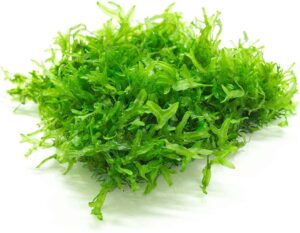
- Scientific Name: Monosolenium tenerum
- Care Level: Easy
- Growth Rate: Medium
- Light Requirement: Low
- CO2 Supplement: Not Necessary
Monosolenium tenerum is one of the ancient plants of the earth as old as 470 million years! They have been surviving for millions of years, so you can imagine how hardy they are! Despite being a rare species, they are well-worthy for use as aquarium carpeting plants for their easy to grow nature.
Monosolenium tenerum is native to Asia, including India, China, and Japan. They have a dark green appearance and, interestingly, no leaf. Instead, they have thallus, a leaf-like green part of the plant they use for photosynthesis and nutrient absorption.
Like the mosses, they are rootless plants having rhizoids. So the type of substrate doesn’t bother them at all. And unfortunately, they don’t get attached to a substrate very well. Still, the propagation method is quite easy. Cut the mother plant into pieces and secure them with the tank bottom with something like a fishing string. As soon as they are settled, they will start growing outwards using spores.
Monosolenium tenerum absorbs nutrients from the water, so nutrient-rich healthy water is desirable for them. They are brittle plants, so always be careful while handling as they snap easily.
The above video was created using InVideo.
How to Grow Aquarium Carpet Plants
Prepare the substrate:
Probably you are going to plant some small plantlets, and they have tiny roots. As we said before, fine powder substrates are most effective for carpeting plants. Prepared nutrient-rich substrates are readily available in aquarium shops and online sites.
Some aquarists prepare the substrate by combining nutrients with different types of suitable sands for getting better results. But for the beginners, it is advisable to pick a prepared package that can be used as an integral substrate bed.
Once you’ve chosen a suitable substrate for your carpeting plants, follow the manufacturer’s instructions to the letter.
Planting :
This step somewhat depends on your selection, but for the most carpet plant species, the course of action will be the same. You will get small carpet plants readily available in pots or cups in pet stores and online shops.
Buy one or two pots depending on your aquarium size. First, separate the aquarium plants from the pot and wash thoroughly. Split the plants into several portions, and insert them uniformly into the substrate with one-inch spacing at least.
The planting task is as simple as stated. Make sure all the roots are properly dipped, and the leaves are exposed to light. Use tweezers and sharp-edged scissors for the planting task.
Lighting For Carpeting Plants:
Light is one of the key elements for a planted tank. You can go for a DYI system or buy a commercial lighting fixture considering your tank size, plant requirements and budget. At the beginning start with 6 hours of light and observe few weeks. You can gradually increase the time up to 10 hours per day.
Regarding the intensity it is a bit tricky. If the carpet plants are not getting enough light they will tend to grow upwards. In such case increase the light intensity. To achieve a successful planted tank balance is the key.
Regular Fertilizer Dosing:
Your supply water may already have some dissolved nutrients and macro-micro elements. Fish waste also acts as fertilizer for the plants. But to maintain a dense carpet as well as heavily planted tank, fertilizer dosing is necessary.
Regular maintenance:
Trimming is the primary and most essential care for all aquarium carpet plants. Trimming will not only help to keep the carpet in good shape but also allow light exposure to every corner of the aquarium. Thus frequent trimming will encourage lateral growth.
Besides ensuring a nutrient-rich substrate for the plants, regular fertilization can help your carpet thrive. Water changes and cleaning of the aquarium are unvarying tasks for all aquariums alike.
Do All Carpet Plants Need CO2 Injection
All plants need CO2 for their photosynthesis but injecting pressurized CO2 may not be necessary in all cases. And that is applicable for carpet plants as well. In the water a certain percentage of CO2 is already dissolved and available for the plants to consume. Also fish exhales CO2 in the water.
The thing is if you have a heavily planted tank then the dissolved CO2 will be consumed pretty quickly and your plants won’t grow much. In this case you need to inject pressurized CO2.
So, what is the recommendation?
Recommendation is if possible get a pressurized CO2 system. You will achieve vivid carpet in no time. But if you are a beginner and just starting the journey, probably you should get a few low demanding plants and kick off your planted aquarium. Check out this article where talked about the detailed process of growing carpeting plants without CO2 in a low tech setup.
Recommended Tools For Planted Tank With Carpeting Plants
Final Thoughts
Aquarium plants proliferate with adequate light, nutrient-rich substrate, and proper CO2 injection. Though we don’t suggest CO2 supplementation from the very beginning, you can start injecting CO2 a few months later, after gaining some experience and confidence over time.
Sometimes it requires several weeks for carpet plants to settle themselves and deliver the desired outcome. If you follow the right steps, your patience will pay off with a beautiful aquarium carpet exhibition.

